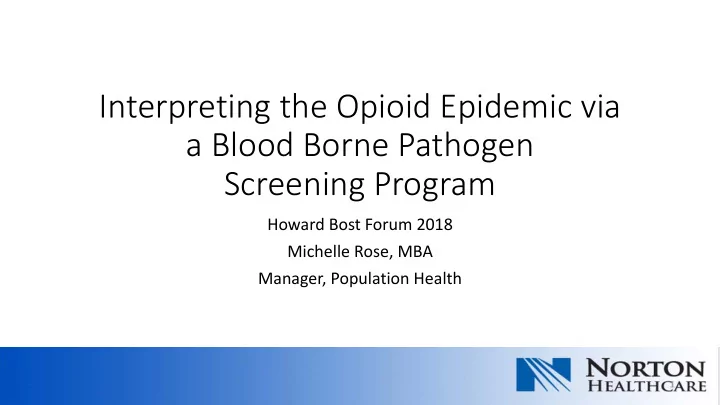

Interpreting the Opioid Epidemic via a Blood Borne Pathogen Screening Program Howard Bost Forum 2018 Michelle Rose, MBA Manager, Population Health
Disclosures • Grant Support from Gilead Sciences Inc. – FOCUS grant 2
Consider: •a blood borne pathogens screening program in context of injection drug use • how data – both the presence and absence of – can inform thinking and medical decision making, and •policies and practices that can result in measureable change. 3
Norton Healthcare Overview 4 Hospitals Market Share 52%: 2,000 Providers (Approx. 2m patient visits per Year) 13 ICCs Payor Mix: Urban 85% Commercial 43.8%, Rural 15% Government 52.3%, (Approx. 1,000 feeder Other 4.0% zip codes) 4
Testing Models HIV • Universal Pregnancy Testing @ week 12 and 36 (Outpatient) • Chief Complaint STI Exposure (Outpatient) (Avg. 2,500 per month) • As Requested or Medically Warranted (Inpatient, Outpatient, ED) • Universal Pregnancy Testing @ week 12 and 36 (Outpatient) HCV • Women Well Women Check (Outpatient) • Chief Complaint STI (Outpatient, ED) (Avg. 3,500 per month) • Chief Complaint Illicit Drug Use (Inpatient, Outpatient, ED) HBV • Universal Pregnancy Testing @ week 12 and 36 (Outpatient) • Chief Complaint STI – MSM & Heterosexual (Outpatient, ED) (Avg. 2,200 per month) 5
Definitions • Universal screening – Screened regardless of known or perceived risk-factor(s). • Risk-based screening – Screened based on known or perceived risk factor(s). • Prevalence - the percentage of a population that is affected with a particular disease at a given time • Population in the denominator (universal or risk-based screened) will change % 6
HIV Transmission Norton Rate 23.5% vs. US Rate 9.0% 24% 17% 23% 53% 6% MSM HETEROSEXUAL MSM/ IDU IDU NHC data 1 May 2016 to 30 June 2018. N= 37,058. New HIV positive diagnosis = 153. 7 *MSM (Men that have sex with men).
HIV IDU 24 Men • HCV and no STI’s – 41.7% • STIs and no HCV – 20.8% • No co-infections – 8.3% • No additional labs – 29.1% 12 Women • HCV and STI’s – 33.3% • STI’s and no HCV – 50.0% • No additional labs – 16.7% NHC data 1 May 2016 to 30 June 2018. N= 37,058. New HIV positive diagnosis = 153. 8
HCV Screening Year 1 Best Practice Advisory (BPA) Targets Baby Boomers 1600 1400 1200 1000 800 600 400 200 0 13 16 19 22 25 28 31 34 37 40 43 46 49 52 55 58 61 64 67 70 73 76 79 82 85 88 91 94 9 NHC Screening 1 May 2016 to 30 June 2017. N=35,622
HCV Screening Year 2 Standing Order Targets Pregnant/Women Childbearing Age 1000 800 600 400 200 0 13 16 19 22 25 28 31 34 37 40 43 46 49 52 55 58 61 64 67 70 73 76 79 82 85 88 91 94 NHC Screening 1 July 2017 to 30 June 2018. N=36,897 10
Outcome of Expanded HCV Screening 327 299 288 258 241 217 Male 162 Female 151 141 99 6 12 28 24 UNDER 20 20-29 30-39 40-49 50-59 60-69 70+ 11 NHC 24 months data. Yr1 HCV RNA+, N=1079. Yr2 HCV RNA+, N=1174
Prevalence of Active HCV Infections by Cohort 3.45% 3.25% 1.0% US US Baby Boomers NHC WCBY CDC data 30 April 2018. Norton Healthcare (NHC) data 1 July 2017 to 30 June 2018 12
Kentucky Senate Bill 250 – Regular Session 2018 Effective 1 July 2018, Kentucky became the first State in the US to mandate universal HCV screening of pregnant women (anticipating 60,000 women screened annually). Moreover, all children born to HCV RNA+ mothers will have “exposure to hepatitis C” noted in their medical record to help ensure that children born to HCV positive mothers are also screened for HCV. 13
Ensuring Infants are Screened per SB250 HCV RNA+ Timeline of auto- Primary Infants chart HCV AB+ testing generates pediatrician is includes auto reflexes Pediatric ID between 2 ambulatory notified of diagnosis – to appointment and 24 referral to HCV ID exposure to Quantitative attended months Pediatrics appointment HCV PCR established Infectious outcome. Disease (ID). Best Practice 14
Not linked Linkage to Care Rates 8% 12% 30% 37% 40% 23% 27% 23% Linked Medically In Progress Incarcerated Linked Substance Use Program Lost to follow-up Deceased Not Linked 15 Declined
Potential Policies and Best Practices Modified Kentucky HIV Legislation – KRS. 214.181 Mandated wrap-around services for Medically Assisted Treatment (MAT) programs Required HIV/ HCV screening for all patients in MAT and substance use programs with the goal of treatment (HIV)/ cure (HCV) Increased access to Mental and Behavioral Health Programs Reflex Quantitative PCR for all HCV AB+ tests Earlier/ More Effective interventions for substance users Comprehensive Public Health Campaigns on HIV, HCV, and STI 16
Recommend
More recommend